Pioneer AVIC-X930BT, AVIC-X9310BT User Manual
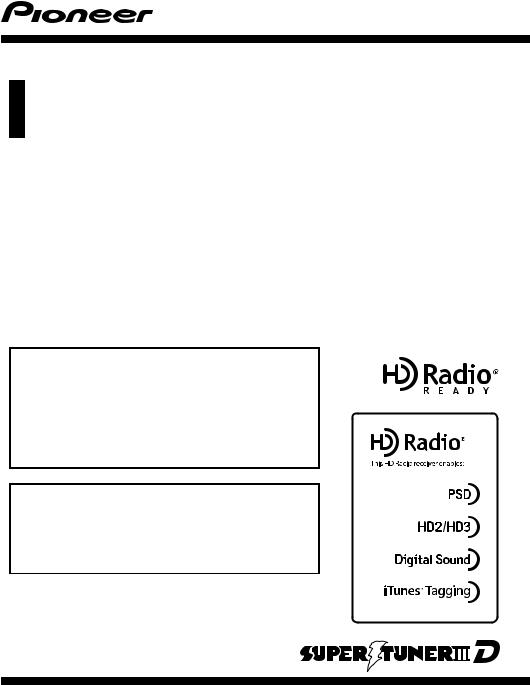
Operation Manual
MULTIMEDIA AV NAVIGATION RECEIVER
AVIC-Z130BT
AVIC-X930BT
AVIC-X9310BT
Notice to all users:
This software requires that the navigation system is properly connected to your vehicle’s parking brake and depending on your vehicle, additional installation may be required. For more information, please contact your Authorized Pioneer Electronics retailer or call us at (800) 421-1404.
Be sure to read Important Information for the User first!
Important Information for the User includes the important information that you must understand before using this navigation system.
English
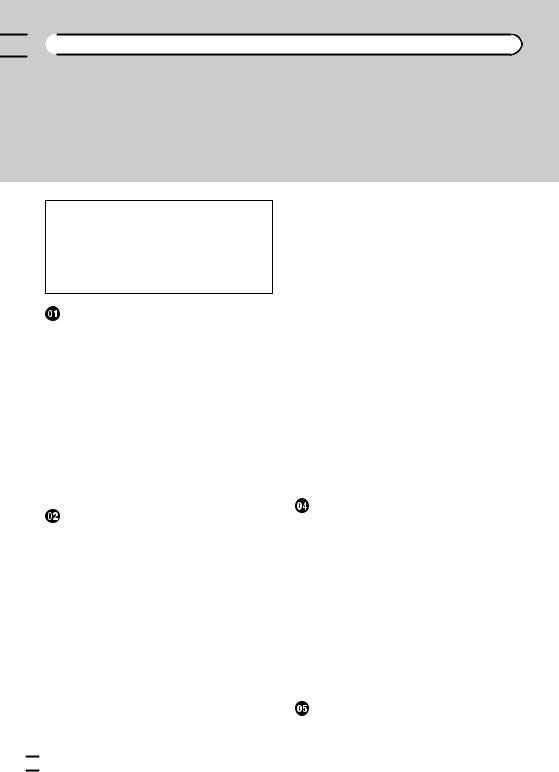

 Contents
Contents
Thank you for buying this Pioneer product.
Please read through these operating instructions so you will know how to operate your model properly. After you have finished reading the instructions, keep this manual in a safe place for future reference.
 Important
Important
The screens shown in the examples may differ from actual screens.
Actual screens may be changed without notice for performance and function improvements.
Introduction |
|
Manual overview 9 |
|
– |
How to use this manual 9 |
– |
Conventions used in this manual 9 |
– |
Terms used in this manual 9 |
Notice regarding video viewing |
10 |
|
|
|||
Notice regarding DVD-Video viewing |
10 |
|
||||
Notice regarding MP3 file usage |
10 |
|
|
|||
iPod compatibility 10 |
|
|
|
|
||
Map coverage |
11 |
|
|
|
|
|
Protecting the LCD panel and screen |
11 |
|||||
Notes on internal memory 11 |
|
|
|
|||
– |
Before removing the vehicle |
|
|
|||
|
battery |
11 |
|
|
|
|
– |
Data subject to erasure |
11 |
|
|
||
Basic operation |
|
|
|
|
||
Checking part names and functions |
12 |
|
||||
– |
Protecting your product from theft |
14 |
||||
Adjusting the LCD panel angle |
|
15 |
|
|
||
Inserting and ejecting a disc |
15 |
|
|
|||
– |
Inserting a disc (for AVIC-Z130BT) |
15 |
||||
– |
Ejecting a disc (for AVIC-Z130BT) |
16 |
||||
–Inserting a disc (for AVIC-X930BT and AVIC-X9310BT) 16
–Ejecting a disc (for AVIC-X930BT and AVIC-X9310BT) 16
Inserting and ejecting an SD memory card 16
–Inserting an SD memory card (for AVICZ130BT) 16
–Ejecting an SD memory card (for AVICZ130BT) 17
– |
Inserting an SD memory card (for AVIC- |
||
|
X930BT and AVIC-X9310BT) |
18 |
|
– |
Ejecting an SD memory card (for AVIC- |
||
|
X930BT and AVIC-X9310BT) |
18 |
|
Plugging and unplugging a USB storage |
|
||
device 19 |
|
|
|
– |
Plugging in a USB storage device |
19 |
|
– |
Unplugging a USB storage device |
19 |
|
Connecting and disconnecting an iPod |
19 |
||
– |
Connecting your iPod 20 |
|
|
– |
Disconnecting your iPod 20 |
|
|
Startup and termination 20
On first-time startup |
20 |
Regular startup 21 |
|
 How to use the navigation menu screens
How to use the navigation menu screens
Screen switching overview |
22 |
|
|
|
|||
What you can do on each menu |
23 |
|
|
||||
Shortcut Menu |
23 |
|
|
|
|
||
– |
Selecting the shortcut |
23 |
|
|
|
||
– |
Removing a shortcut |
24 |
|
|
|
||
Operating list screens (e.g. POI list) |
24 |
|
|||||
Operating the on-screen keyboard |
24 |
|
|||||
How to use the map |
|
|
|
|
|||
How to read the map screen |
25 |
|
|
|
|||
– |
Enlarged map of the intersection |
26 |
|||||
– |
Display during freeway driving |
27 |
|
||||
Types of the road stored in the map |
|
|
|||||
database |
27 |
|
|
|
|
|
|
Operating the map screen |
27 |
|
|
|
|||
– |
Changing the scale of the map |
27 |
|||||
– |
Switching the map orientation |
28 |
|
||||
– |
Scrolling the map to the position you |
||||||
|
want to see |
28 |
|
|
|
|
|
– |
Viewing information about a specified |
||||||
|
location |
28 |
|
|
|
|
|
– |
Using shortcut menus on the map |
29 |
|||||
Switching the view mode 30 |
|
|
|
||||
Eco-friendly driving functions |
|
|
|
||||
Checking the eco-friendly driving status |
32 |
||||||
Displaying Eco Drive Level guidance |
33 |
|
|||||
 2
2 En
En

 Contents
Contents
Sudden start alert 33
 Searching for and selecting a location
Searching for and selecting a location
The basic flow of creating your route |
34 |
Searching for a location by address |
35 |
– Searching for a city name first |
35 |
–Finding the location by specifying the house number 36
Setting up a route to your home |
37 |
||
Searching for Points of Interest (POI) 37 |
|||
– |
Searching for POIs by preset |
||
|
categories |
37 |
|
– |
Searching for a POI directly from the |
||
|
name of the facilities 37 |
|
|
– |
Searching for a nearby POI |
38 |
|
– |
Searching for POIs around the |
||
|
destination |
38 |
|
– |
Searching for POIs around the city 38 |
||
Selecting destination from “Favorites” 39 Searching for POIs by using the data on the
SD memory card 40
Selecting a location you searched for recently 40
Searching for a location by coordinates 40
After the location is decided |
|
Setting a route to your destination |
42 |
– Displaying multiple routes |
42 |
 Checking and modifying the current
Checking and modifying the current
route |
|
|
|
Displaying the route overview |
43 |
||
Modifying the route calculation |
|
||
conditions 43 |
|
|
|
– |
Items that users can operate 43 |
||
Checking the current itinerary |
44 |
||
Editing waypoints 45 |
|
|
|
– |
Adding a waypoint |
45 |
|
– |
Deleting a waypoint |
45 |
|
– |
Sorting waypoints |
46 |
|
Canceling the route guidance |
46 |
||
Registering and editing locations |
|||
Storing favorite locations |
47 |
|
|
–Registering a location by “Favorites” 47
–Registering a location by scroll mode 47
Editing registered locations 47
– |
Editing the favorite location in the |
|
|
list |
47 |
– |
Editing your home 48 |
|
– |
Sorting the favorite locations in the |
|
|
list |
48 |
–Deleting a favorite location from the list 49
Exporting and importing favorite |
|
|
locations 49 |
|
|
– |
Exporting favorite locations |
49 |
– |
Importing favorite locations |
49 |
Deleting the destination history from the list 50
 Using traffic information
Using traffic information
Checking all traffic information 51 Checking traffic information on the
route 52
How to read traffic information on the map 52
Viewing the traffic flow 52
Setting an alternative route to avoid traffic congestion 53
– Checking for traffic congestion automatically 54
–Checking traffic information manually 54
Selecting traffic information to display 55 Selecting preferred RDS-TMC service
provider manually 55
 Registering and connecting a Bluetooth
Registering and connecting a Bluetooth
device |
|
Preparing communication devices |
56 |
Registering your Bluetooth devices |
56 |
–Searching for nearby Bluetooth devices 56
En  3
3


 Contents
Contents
– |
Pairing from your Bluetooth |
|
|
devices |
57 |
– |
Searching for a specified Bluetooth |
|
|
device |
58 |
– |
Deleting a registered device 59 |
|
Connecting a registered Bluetooth device manually 59
– Setting for priority connecting 60
 Using hands-free phoning
Using hands-free phoning
Displaying the phone menu 61
Making a phone call |
61 |
|
|
– |
Direct dialing |
61 |
|
– |
Making a call home easily |
62 |
|
– |
Calling a number in the phone |
||
|
book 62 |
|
|
– |
Dialing from the history |
63 |
|
– |
Dialing a favorite location |
63 |
|
– |
Dialing a facility’s phone number 63 |
|||||
– |
Dialing from the map |
64 |
|
|||
Receiving a phone call |
64 |
|
|
|
||
– |
Answering an incoming call |
64 |
||||
Transferring the phone book |
|
65 |
|
|||
– |
Deleting registered contacts |
66 |
||||
Changing the phone settings |
66 |
|
||||
– |
Editing the device name |
66 |
|
|||
– |
Editing the password |
66 |
|
|||
– |
Stopping Bluetooth wave |
|
||||
|
transmission 67 |
|
|
|
|
|
– |
Echo canceling and noise |
|
||||
|
reduction |
67 |
|
|
|
|
– |
Answering a call automatically 67 |
|||||
– |
Setting the automatic rejection |
|||||
|
function |
67 |
|
|
|
|
– |
Clearing memory |
68 |
|
|
|
|
– |
Updating the Bluetooth wireless |
|||||
|
technology software |
68 |
|
|||
Notes for hands-free phoning |
69 |
|
||||
Basic operations of the AV source |
||||||
Displaying the AV operation screen |
70 |
|||||
– |
Selecting a source |
70 |
|
|
||
Operating list screens (e.g. iPod list screen) 70
– Switching between the AV operation
|
screen and the list screen |
70 |
|||
– |
Selecting an item |
71 |
|
|
|
– |
Returning to the previous display 71 |
||||
Using the radio (FM) |
|
|
|
||
Starting procedure |
72 |
|
|
|
|
Reading the screen |
72 |
|
|
|
|
Using the touch panel keys |
73 |
|
|||
– |
Storing and recalling broadcast |
||||
|
frequencies |
73 |
|
|
|
Operating by hardware buttons |
74 |
||||
Using advanced functions |
74 |
|
|||
– |
Storing the strongest broadcast |
||||
|
frequencies |
74 |
|
|
|
– Tuning in strong signals |
74 |
||||
Using the radio (AM) |
|
|
|
||
Starting procedure |
76 |
|
|
|
|
Reading the screen |
76 |
|
|
|
|
Using the touch panel keys |
77 |
|
|||
– |
Storing and recalling broadcast |
||||
|
frequencies |
77 |
|
|
|
Operating by hardware buttons |
78 |
||||
Using advanced functions |
78 |
|
|||
– |
Storing the strongest broadcast |
||||
|
frequencies |
78 |
|
|
|
– Tuning in strong signals |
78 |
||||
HD Radio™ reception |
|
|
|
||
HD Radio broadcasting |
80 |
|
|
||
Starting procedure |
80 |
|
|
|
|
Reading the screen |
81 |
|
|
|
|
Using the touch panel keys |
82 |
|
|||
– |
Storing and recalling broadcast |
||||
|
frequencies |
83 |
|
|
|
Operating by hardware buttons 83 Switching the display 83
– Scrolling the detailed information 84 Storing song information to an iPod (iTunes
Tagging) 84
 4
4 En
En

 Contents
Contents
Using advanced functions |
84 |
|
|
|
– Storing the strongest broadcast |
|
|||
frequencies |
85 |
|
|
|
– Switching the seek mode |
85 |
|
||
– Tuning in strong signals |
85 |
|
||
– Switching the reception mode |
85 |
|||
Playing audio CDs |
|
|
|
|
Starting procedure |
87 |
|
|
|
Reading the screen |
87 |
|
|
|
Using the touch panel keys |
88 |
|
|
|
Operating by hardware buttons |
89 |
|
||
Using advanced functions |
89 |
|
|
|
Playing music files on ROM |
|
|
||
Starting procedure |
90 |
|
|
|
Reading the screen |
90 |
|
|
|
Using the touch panel keys |
92 |
|
|
|
Operating by hardware buttons |
93 |
|
||
Using advanced functions |
93 |
|
|
|
Playing a DVD-Video |
|
|
|
|
Starting procedure |
95 |
|
|
|
Reading the screen |
95 |
|
|
|
Using the touch panel keys |
96 |
|
|
|
– Resuming playback (Bookmark) |
97 |
|||
–Searching for a specific scene and starting playback from a specified
|
time |
98 |
|
|
|
– |
Direct number search |
98 |
|
||
– |
Operating the DVD menu |
98 |
|||
– |
Using DVD menu by touch panel |
||||
|
keys |
98 |
|
|
|
– |
Frame-by-frame playback |
99 |
|||
– |
Slow motion playback |
99 |
|
||
Operating by hardware buttons |
99 |
||||
Using advanced functions |
99 |
|
|||
Playing a DivX video |
|
|
|||
Starting procedure |
101 |
|
|
||
Reading the screen |
101 |
|
|
||
Using the touch panel keys |
102 |
|
|||
– |
Frame-by-frame playback |
103 |
|||
– |
Slow motion playback |
103 |
|||
– Starting playback from a specified time 104
Operating by hardware buttons 104 Using advanced functions 104
 DVD-Video or DivX setup
DVD-Video or DivX setup
Displaying DVD/DivX® Setup menu 105 Setting the top-priority languages 105 Setting the angle icon display 105
Setting the aspect ratio |
106 |
Setting the parental lock |
106 |
–Setting the code number and level 106
Setting the auto play 107 |
|
Setting the subtitle file for DivX |
107 |
Language code chart for DVDs |
108 |
 Playing music files (from USB or SD)
Playing music files (from USB or SD)
Starting procedure |
109 |
Reading the screen |
109 |
Using the touch panel keys (Music) 111 |
|
Operating by hardware buttons 112 |
|
Using advanced functions 112 |
|
 Playing video files (from USB or SD)
Playing video files (from USB or SD)
Starting procedure |
113 |
Reading the screen |
113 |
Using the touch panel keys (Video) 114
– Searching for a specific scene and starting playback from a specified time 115
Operating by hardware buttons |
115 |
||
Using advanced functions |
115 |
|
|
Using an iPod (iPod) |
|
|
|
Starting procedure |
116 |
|
|
Reading the screen |
116 |
|
|
Using the touch panel keys |
118 |
|
|
Operating by hardware buttons |
120 |
||
Starting the video playback |
120 |
|
|
Narrowing down a song or video with the list 120
Operating the functions from your iPod 121 Playing MusicSphere 122
En  5
5
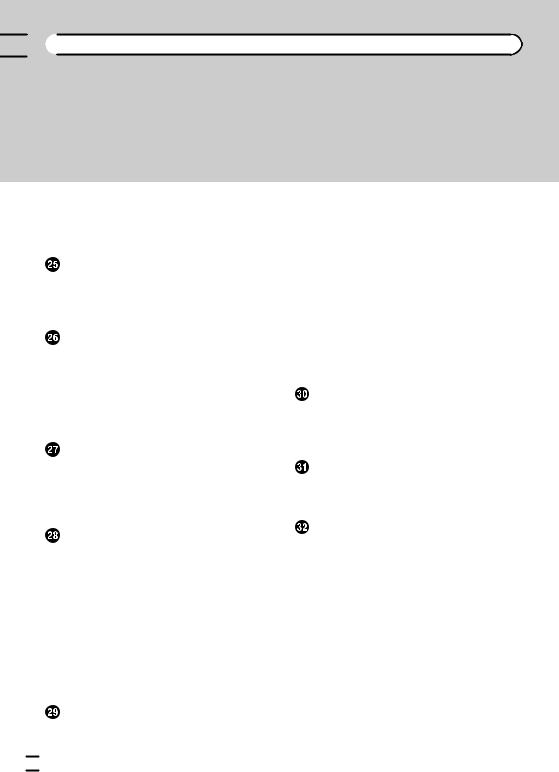

 Contents
Contents
– |
Starting procedure 122 |
|
||
– |
Reading the screen |
122 |
|
|
– Using the touch panel keys |
122 |
|||
Using advanced functions |
122 |
|
||
Using Pandora® |
|
|
|
|
Starting procedure |
124 |
|
|
|
Reading the screen |
124 |
|
|
|
Using the touch panel keys |
126 |
|
||
Operating by hardware buttons |
126 |
|||
Using Aha Radio |
|
|
|
|
Starting procedure |
127 |
|
|
|
Reading the screen |
128 |
|
|
|
Using the touch panel keys |
129 |
|
||
Functions coupled with Aha Radio and the navigation system 130
–Displaying POIs obtained with Aha Radio 130
Using the Bluetooth audio player |
|
|||
Starting procedure |
131 |
|
|
|
Reading the screen |
131 |
|
|
|
Using the touch panel keys |
133 |
|
||
Operating by hardware buttons |
133 |
|
||
Using advanced functions |
134 |
|
||
Using the XM tuner |
|
|
|
|
Starting procedure |
135 |
|
|
|
Reading the screen |
135 |
|
|
|
Using the touch panel keys |
137 |
|
||
– Selecting an XM channel directly |
138 |
|||
– Displaying the Radio ID |
138 |
|
||
– Storing and recalling broadcast |
|
|||
stations 139 |
|
|
|
|
– Selecting a channel from the list |
139 |
|||
– Using “MyMix” function |
139 |
|
||
Operating by hardware buttons |
140 |
|
||
Using advanced functions |
140 |
|
||
– Setting the memorized songs 140 |
||||
Using the SIRIUS tuner |
|
|
|
|
Starting procedure |
141 |
|
|
|
Reading the screen |
141 |
|
|
|
Using the touch panel keys |
142 |
||
– |
Selecting a SIRIUS channel |
||
|
directly |
143 |
|
– |
Display the Radio ID |
143 |
|
– |
Storing and recalling broadcast |
||
|
stations |
143 |
|
– |
Using the song alert function 144 |
||
–Using the “Instant Replay” function 144
Operating by hardware buttons 145
Using advanced functions 145 |
|
|
– Setting the memorized songs |
145 |
|
– |
Using the Game Alert function |
145 |
– |
Displaying Game Information |
146 |
Using AV input |
|
|
|
Reading the screen |
147 |
|
|
Using AV1 |
147 |
|
|
Using AV2 |
147 |
|
|
Using the touch panel keys |
147 |
||
Using the external unit (EXT1, EXT2) |
|||
Starting procedure |
148 |
|
|
Reading the screen |
148 |
|
|
Using the touch panel keys |
149 |
||
Customizing preferences |
|
||
Displaying the screen for navigation |
|||
settings |
150 |
|
|
Checking the connections of leads 150 |
|||
Checking sensor learning status and driving
status |
151 |
|
– |
Clearing status 151 |
|
Using the fuel consumption function 152 |
||
– |
Inputting the fuel consumption |
|
|
information for calculating the fuel |
|
|
cost |
152 |
– |
Calculating the fuel consumption 152 |
|
– |
Exporting the data of fuel cost |
|
|
information 153 |
|
Recording your travel history 154 Using the demonstration guidance 154 Registering your home 154
 6
6 En
En

 Contents
Contents
Correcting the current location |
155 |
|
Changing the eco-function setting 155 |
||
Displaying the screen for map settings |
156 |
|
Setting the auto-zoom display |
156 |
|
Setting the detailed city map |
156 |
|
Setting the barrier graphic for city map |
157 |
|
Displaying the traffic notification icon |
157 |
|
Displaying the Bluetooth connection |
|
|
icon 158 |
|
|
Setting the current street name display |
158 |
|
Setting the display of icons of favorite |
|
|
locations 158 |
|
|
Displaying the 3D landmarks |
158 |
|
Displaying maneuvers 159 |
|
|
Displaying the fuel consumption information 159
Displaying POI on the map 159
–Displaying preinstalled POIs on the map 159
– Displaying the customized POIs 160 Changing the view mode 161
Setting the map color change between day and night 161
Changing the road color 161 Changing the setting of navigation
interruption screen 161
Selecting the “Quick Access” menu 162 Displaying the screen for system
settings 162
– Customizing the regional settings 163
–Setting the Volume for Guidance and Phone 165
–Changing the preinstalled splash screen 165
–Changing to the splash screen stored
in the SD memory card 165
– Setting for rear view camera 166
–Adjusting the response positions of the touch panel (touch panel
|
calibration) 167 |
– |
Setting the illumination color 167 |
– |
Checking the version information 168 |
Selecting the video for rear display 168 Adjusting the picture 169
Displaying the screen for AV system
settings |
170 |
|
|
– |
Setting video input 1 (AV1) |
170 |
|
– |
Setting video input 2 (AV2) |
171 |
|
– |
Changing the wide screen mode 171 |
||
– |
Setting the rear output 171 |
|
|
– |
Switching the muting/attenuation |
||
|
timing |
172 |
|
– |
Switching the muting/attenuation |
||
|
level |
172 |
|
– |
Acquiring/Cataloging iPod music |
||
|
information 173 |
|
|
–Displaying your DivX VOD registration code 174
–Displaying your DivX VOD
|
deregistration code |
174 |
|
|
Displaying the screen for AV sound |
||||
settings 174 |
|
|
|
|
– |
Using balance adjustment |
175 |
||
– |
Using the equalizer |
175 |
|
|
– |
Adjusting the equalizer curve |
|||
|
automatically (Auto EQ) |
177 |
||
– |
Using sonic center control |
179 |
||
– |
Adjusting loudness |
180 |
|
|
– |
Using subwoofer output |
180 |
||
– |
Using the high pass filter |
|
180 |
|
– |
Adjusting source levels |
180 |
||
– |
Enhancing bass (Bass Booster) 181 |
|||
Replicating the settings |
181 |
|
|
|
Turning off the screen 181 |
|
|
||
 Operating your navigation system with
Operating your navigation system with
voice |
|
|
|
To Ensure Safe Driving |
182 |
|
|
Basics of the voice operation 182 |
|
||
– |
Flow of the voice operation |
182 |
|
– |
Starting the voice operation |
182 |
|
– |
How to use the voice operation 183 |
||
Available basic voice commands |
185 |
||
– |
Basic commands |
185 |
|
En  7
7


 Contents
Contents
– |
Voice operation for the iPod |
185 |
|||||
– |
Voice operation for AV source (other |
||||||
|
than iPod) |
186 |
|
|
|
|
|
– |
Voice commands related to hands-free |
||||||
|
phoning 187 |
|
|
|
|
|
|
Tips for the voice operation |
188 |
|
|
||||
Other functions |
|
|
|
|
|
|
|
Setting the anti-theft function |
189 |
|
|||||
– |
Setting the password |
189 |
|
|
|||
– |
Entering the password |
189 |
|
|
|||
– |
Deleting the password |
189 |
|
|
|||
– |
Forgotten password |
189 |
|
|
|||
Returning the navigation system to the |
|||||||
default or factory settings |
190 |
|
|
||||
– |
Restoring the default setting |
|
190 |
||||
– |
Returning the navigation system to the |
||||||
|
initial state |
190 |
|
|
|
|
|
– |
Setting items to be deleted |
191 |
|||||
Appendix |
|
|
|
|
|
|
|
Troubleshooting |
193 |
|
|
|
|
|
|
Messages and how to react to them |
198 |
||||||
Messages for audio functions |
200 |
|
|||||
Positioning technology |
202 |
|
|
|
|||
– |
Positioning by GPS |
202 |
|
|
|||
– |
Positioning by dead reckoning |
202 |
|||||
– |
How do GPS and dead reckoning work |
||||||
|
together? |
202 |
|
|
|
|
|
Handling large errors |
203 |
|
|
|
|||
– |
When positioning by GPS is |
|
|
||||
|
impossible |
203 |
|
|
|
|
|
–Conditions likely to cause noticeable positioning errors 204
Route setting information |
206 |
|
– |
Route search specifications 206 |
|
Handling and care of discs |
206 |
|
– |
Built-in drive and care |
207 |
–Ambient conditions for playing a disc 207
Playable discs 207
– |
DVD-Video and CD 207 |
– |
AVCHD recorded discs 208 |
– |
Playing DualDisc |
208 |
|
||
– |
Dolby Digital |
208 |
|
|
|
Detailed information for playable media |
208 |
||||
– |
Compatibility |
208 |
|
||
– |
Media compatibility chart 211 |
|
|||
Bluetooth 215 |
|
|
|
||
About the SAT RADIO READY Logo 215 |
|||||
HD Radio™ Technology |
216 |
|
|||
SD and SDHC logo |
216 |
|
|||
WMA/WMV |
216 |
|
|
|
|
DivX |
216 |
|
|
|
|
AAC |
217 |
|
|
|
|
Detailed information regarding connected |
|||||
iPod devices 217 |
|
|
|
||
– |
iPod and iPhone |
217 |
|
||
– |
iTunes |
217 |
|
|
|
Using App-based Connected Contents |
217 |
||||
–Pandora 218
–Aha Radio 218
Using the LCD screen correctly |
218 |
|||
– |
Handling the LCD screen |
218 |
||
– |
Liquid crystal display (LCD) |
|
||
|
screen 218 |
|
|
|
– |
Maintaining the LCD screen 218 |
|||
– |
LED (light-emitting diode) |
|
||
|
backlight 219 |
|
|
|
Display information |
220 |
|
|
|
– |
Destination Menu |
220 |
|
|
– |
Phone Menu |
220 |
|
|
– |
Settings Menu |
221 |
|
|
– |
Navi Settings menu |
221 |
|
|
– |
System Settings menu 222 |
|||
– |
Map Settings menu |
222 |
|
|
– |
Bluetooth Settings menu |
223 |
||
– |
AV System Settings menu |
223 |
||
– |
AV Sound Settings menu |
224 |
||
Glossary 225
Specifications 228
 8
8 En
En

|
Chapter |
Introduction |
01 |
Manual overview
Before using this product, be sure to read Important Information for the User (a separate manual) which contains warnings, cautions, and other important information that you should note.
The screen examples shown in this manual are the ones for AVIC-Z130BT. If you use a different model, the screens that appear may differ from the examples in the manual.
How to use this manual
Finding the operation procedure for what you want to do
When you have decided what you want to do, you can find the page you need from the Contents.
Finding the operation procedure from a menu name
If you want to check the meaning of an item displayed on the screen, you will find the necessary page from the Display information at the end of the manual.
Glossary
Use the glossary to find the meanings of terms.
e.g.)
“Destination Menu” screen or “AV Source” screen
!Touch panel keys that are available on the screen are described in bold in brackets [ ]: e.g.)
[Destination], [Settings].
!Extra information, alternatives and other notes are presented in the following format:
e.g.)
p If the home location has not been stored yet, set the location first.
!Functions of other keys on the same screen are indicated with # at the beginning of the description:
e.g.)
# If you touch [OK], the entry is deleted.
!References are indicated like this: e.g.)
= For details of the operations, refer to
Screen switching overview on page 22.
Terms used in this manual
“Front display” and “Rear display”
In this manual, the screen that is attached to the body of this navigation unit will be referred to as the “Front display”. Any additional screen that is commercially available and can be connected to this navigation unit will be referred to as the “Rear display”.
Introduction
Conventions used in this manual
Before moving on, take a few minutes to read the following information about the conventions used in this manual. Familiarity with these conventions will help you greatly as you learn how to use your new equipment.
!Buttons on your navigation system are described in ALL CAPITAL, BOLD lettering: e.g.)
HOME button, MODE button.
!Menu items, screen titles, and functional components are described in bold with double quotation marks “ ”:
“Video image”
“Video image” in this manual indicates moving images of DVD-Video, DivX®, iPod, and any equipment that is connected to this system with an RCA cable, such as general-purpose AV equipment.
En  9
9

Chapter |
|
01 |
Introduction |
“External storage device (USB, SD)”
The SD memory card, SDHC memory card, microSD card, microSDHC card and USB memory device are collectively referred to as the “external storage device (USB, SD)”. If it indicates the USB memory only, it is referred to as the “USB storage device”.
“SD memory card”
The SD memory card, SDHC memory card, microSD card and microSDHC card are collectively referred to as the “SD memory card”.
Notice regarding video viewing
Remember that use of this system for commercial or public viewing purposes may constitute an infringement on the author’s rights as protected by the Copyright Law.
Notice regarding DVDVideo viewing
This item incorporates copy protection technology that is protected by U.S. patents and other intellectual property rights of Rovi Corporation. Reverse engineering and disassembly are prohibited.
Notice regarding MP3 file usage
Supply of this navigation system conveys only a license for private, non-commercial use and does not convey a license nor imply any right to use this product in any commercial (i.e. rev- enue-generating), real time broadcasting (terrestrial, satellite, cable and/or any other media), broadcasting/streaming via internet, intranets and/or other networks or in other electronic content distribution systems, such
as pay-audio or audio-on-demand applications. An independent license for such use is required. For details, please visit http://www.mp3licensing.com.
iPod compatibility
This product supports only the following iPod models and iPod software versions. Others may not work correctly.
!iPod touch fourth generation: Ver. 4.1
!iPod touch third generation: Ver. 4.1
!iPod touch second generation: Ver. 4.1
!iPod touch first generation: Ver. 3.1.3
!iPod classic 120GB: Ver. 2.0.1
!iPod classic 160GB (2009): Ver. 2.0.4
!iPod classic 80GB: Ver. 1.1.2
!iPod classic 160GB (2007): Ver. 1.1.2
!iPod with video: Ver. 1.3
!iPod nano sixth generation: Ver. 1.0
!iPod nano fifth generation: Ver. 1.0.2
!iPod nano fourth generation: Ver. 1.0.4
!iPod nano third generation: Ver. 1.1.3
!iPod nano second generation: Ver. 1.1.3
!iPod nano first generation: Ver. 1.3.1
!iPhone 4: Ver. 4.1
!iPhone 3GS: Ver. 4.1
!iPhone 3G: Ver. 4.1
!iPhone: Ver. 3.1.3
pIn this manual, iPod and iPhone will be referred to as iPod.
pWhen you use this navigation system with a Pioneer USB interface cable for iPod (CDIU51V) (sold separately), you can control an iPod compatible with this navigation system.
pOperation methods may vary depending on the iPod models and the software version of iPod.
pDepending on the software version of the iPod, it may not be compatible with this equipment.
For details about iPod compatibility with
this navigation system, refer to the information on our website.
 10
10 En
En

 Introduction
Introduction
Map coverage
For details about the map coverage of this navigation system, refer to the information on our website.
Protecting the LCD panel and screen
pDo not allow direct sunlight to fall on the LCD screen when this product is not being used. Extended exposure to direct sunlight can result in LCD screen malfunction due
to the resulting high temperatures.
pWhen using a cellular phone, keep the antenna of the cellular phone away from the
LCD screen to prevent disruption of the video in the form of spots, colored stripes, etc.
pTo protect the LCD screen from damage, be sure to touch the touch panel keys with
your finger only and gently touch the screen.
Notes on internal memory
Before removing the vehicle battery
If the battery is disconnected or discharged, the memory will be erased and must be reprogrammed.
pSome data remains. Be sure to read Setting items to be deleted first.
=For details, refer to Setting items to be deleted on page 191.
Data subject to erasure
The information is erased by disconnecting the yellow lead from the battery (or removing the battery itself).
pSome data remains. Be sure to read Setting items to be deleted first.
=For details, refer to Setting items to be deleted on page 191.
Chapter
01 |
Introduction
En  11
11
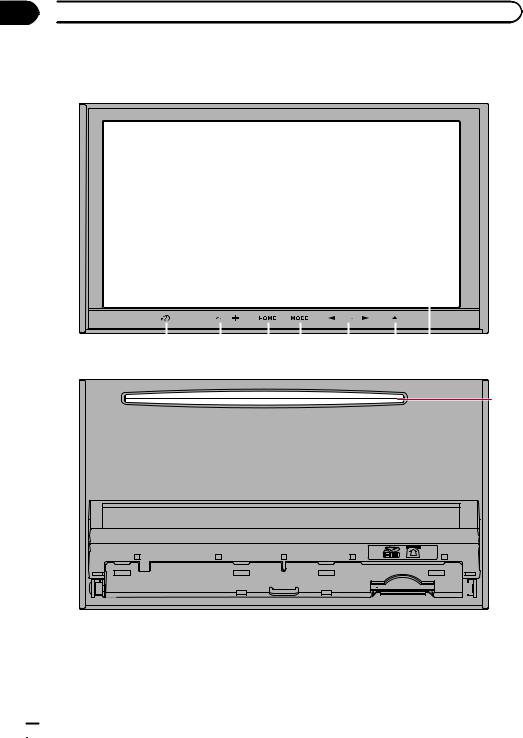
Chapter
02  Basic operation
Basic operation
Checking part names and functions
This chapter gives information about the names of the parts and the main features using the buttons.
|
|
|
|
|
|
|
|
|
|
|
|
|
|
|
|
|
|
|
|
|
|
|
|
|
|
|
|
|
|
|
|
|
|
|
|
|
|
|
|
|
|
|
|
|
|
|
|
|
|
|
|
|
|
|
|
|
|
|
|
|
|
|
|
|
|
|
|
|
|
|
|
|
|
|
|
|
|
|
|
|
|
|
|
|
|
|
|
1 |
2 |
3 |
4 |
5 |
6 |
7 |
|||||||||||||||
AVIC-Z130BT (with the LCD panel closed)
8


 9
9
AVIC-Z130BT (with the LCD panel open)
 12
12 En
En
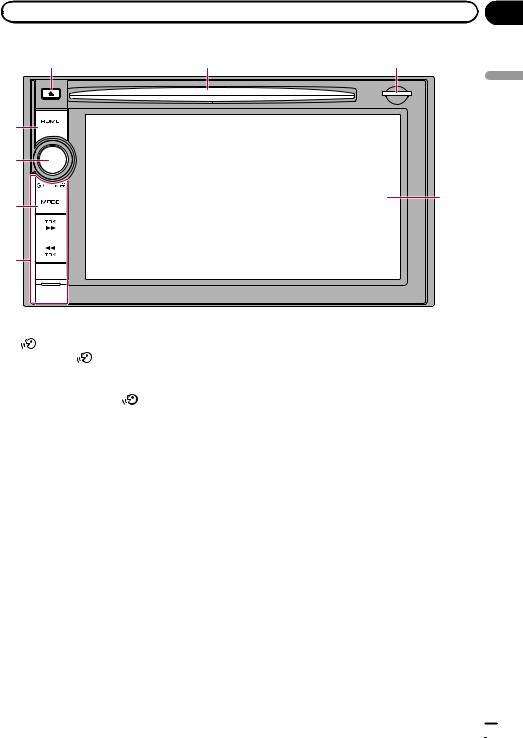
|
Chapter |
Basic operation |
02 |
6 |
8 |
9 |
3
a
7
4
5 
 b
b
c 

AVIC-X930BT, AVIC-X9310BT |
|
||||
1 |
button |
|
|
! Press to display the map screen while |
|
! |
Press the |
button to activate voice op- |
the navigation function screen is dis- |
||
|
erations. |
|
|
played. |
|
! |
= For details, refer to Chapter 33. |
! Press and hold to display the “Picture |
|||
Press and hold the |
button to switch |
Adjustment” screen. |
|||
|
the AV source to mute. |
|
= For details, refer to Adjusting the pic- |
||
|
To cancel the muting, press and hold it |
ture on page 169. |
|||
|
again. |
|
|
5 TRK button |
|
|
|
|
|
||
2 VOL (+/–) button |
|
Press to perform manual seek tuning, fast |
|||
Press to adjust the AV (Audio and Video) |
forward, reverse and track search controls. |
||||
source volume. |
|
|
= For details, refer to the descriptions from |
||
3 HOME button |
|
|
Chapter 14 to Chapter 31. |
||
|
|
|
|||
! Press the HOME button to display the |
6 hbutton |
||||
|
“Top Menu” screen. |
|
7 LCD screen |
||
! Press to switch between the Classic |
|||||
|
Menu and the Shortcut Menu while the |
8 Disc-loading slot |
|||
|
“Top Menu” is displayed. |
||||
|
Insert a disc to play. |
||||
|
= For details, refer to What you can do |
||||
|
= For details, refer to Inserting and ejecting |
||||
|
on each menu on page 23. |
||||
|
a disc on page 15. |
||||
! Press and hold to turn off the screen dis- |
|||||
|
|||||
|
play. |
|
|
9 SD card slot |
|
|
|
|
|
= For details, refer to Inserting and ejecting |
|
4 MODE button |
an SD memory card on page 16. |
|
! Press to switch between the map screen |
||
|
||
and the AV operation screen. |
|
operation Basic
En  13
13
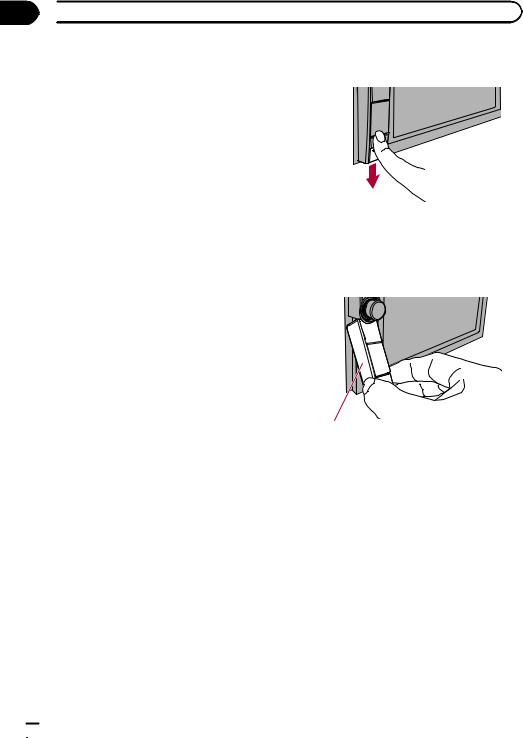
Chapter
02  Basic operation
Basic operation
aMulti-control (Volume knob/
 /MUTE)
/MUTE)
!Rotate to adjust the AV (Audio and Video) source volume.
!Press the center of Multi-control to hear the route guidance.
!Press and hold the center of Multi-con- trol to mute the AV (Audio and Video) source. To cancel the muting, press and hold it again.
bFront panel
cDetach button
Press to remove the front panel from the navigation system.
=For details, refer to Removing the front panel on this page.
1 Press and hold the Detach button, and slide it down.
When you release your finger, the bottom of the front panel separates slightly from the navigation system.
2 Gently grip the bottom of the front panel and slowly pull it outward.
Protecting your product from theft
pThis function is available for AVIC-X930BT and AVIC-X9310BT.
The front panel can be detached from the navigation system to discourage theft, as described below.
 CAUTION
CAUTION
!Do not expose the front panel to excessive shock or disassemble it.
!Never grip the buttons tightly or use force when removing or attaching.
!Keep the front panel out of reach of small children to prevent them from putting it in their mouths.
!After removing the front panel, keep it in a safe place so it is not scratched or damaged.
!Keep the front panel out of direct sunlight and high temperatures.
!When removing or attaching the front panel, do so after turning the ignition switch off (ACC OFF).
Removing the front panel
pThe navigation system cannot be operated while the front panel is removed from the navigation system.
Front panel
Attaching the front panel
1Slide the front panel all the way into the navigation system.
Make sure the front panel is securely connected to the mounting hooks of the navigation system.
2Push the lower part of the front panel until you hear a click.
If you fail to successfully attach the front panel to the navigation system, try again but be care-
ful not to force it as the panel could be damaged.
 14
14 En
En
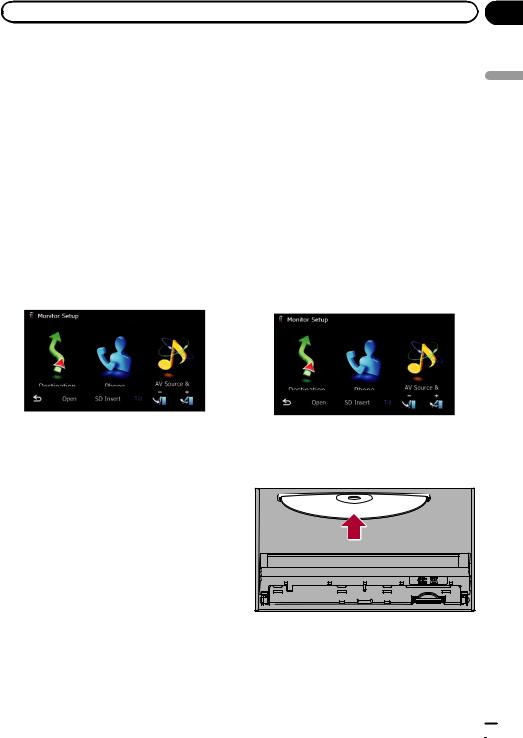
|
Chapter |
Basic operation |
02 |
Adjusting the LCD panel angle
pThis function is available for AVIC-Z130BT only.
 WARNING
WARNING
When opening, closing and adjusting the angle of the LCD panel, be careful not to get your fingers caught.
 CAUTION
CAUTION
Do not open or close the LCD panel by force. This may cause malfunction.
1 Press the hbutton.
The “Monitor Setup” screen appears.
2 Touch  or
or  to adjust the angle.
to adjust the angle.
3 Touch  .
.
pThe adjusted angle of the LCD panel will be memorized and the LCD panel will automa-
tically return to that angle the next time the LCD panel is opened or closed.
Inserting and ejecting a disc
Inserting a disc (for AVIC-Z130BT)
 WARNING
WARNING
!When opening, closing and adjusting the angle of the LCD panel, be careful not to get your fingers caught.
!Do not use with the LCD panel left open. If LCD panel is left open, it may result in injury in the event of an accident.
 CAUTION
CAUTION
!Do not open or close the LCD panel by force. This may cause malfunction.
!Do not operate this navigation system until the LCD panel completely opens or closes. If this navigation system is operated while the LCD panel is opening or closing, the LCD panel may stop at that angle for safety.
!Do not place a glass or a can on the open LCD panel. Doing so may break this navigation system.
!Do not insert anything other than a disc into the disc-loading slot.
1 Press the hbutton.
The “Monitor Setup” screen appears.
2 Touch [Open].
The LCD panel opens, and the disc-loading slot appears.
3 Insert a disc into the disc-loading slot.
The disc is loaded, and the LCD panel closes.
operation Basic
En  15
15
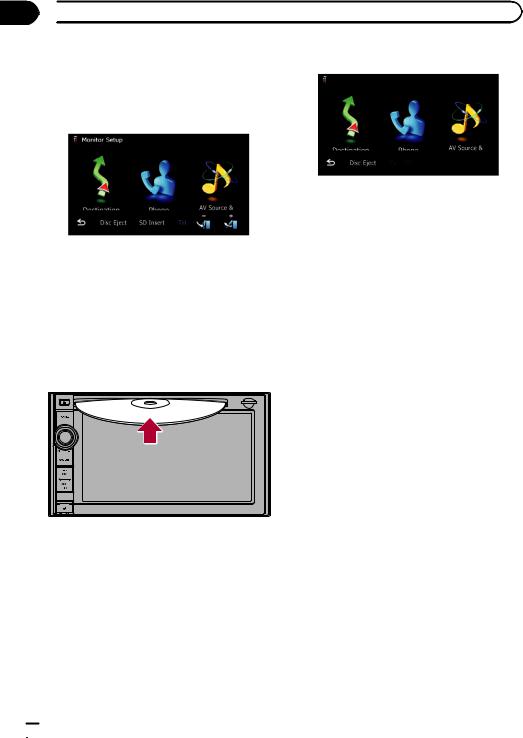
Chapter
02  Basic operation
Basic operation
Ejecting a disc (for AVIC-Z130BT) |
2 Touch [Disc Eject]. |
1 Press the hbutton.
The “Monitor Setup” screen appears.
2 Touch [Disc Eject].
The LCD panel opens, and the disc is ejected.
3 Remove the disc, and press the hbutton.
The LCD panel closes.
Inserting a disc (for AVICX930BT and AVIC-X9310BT)
% Insert a disc into the disc-loading slot.
pDo not insert anything other than a disc into the disc-loading slot.
The disc is ejected.
Inserting and ejecting an SD memory card
 CAUTION
CAUTION
!Ejecting an SD memory card during data transfer can damage the SD memory card. Be sure to eject the SD memory card by the procedure described in this manual.
!If data loss or corruption occurs on the storage device for any reason, it is usually not possible to recover the data. Pioneer accepts no liability for damages, costs or expenses arising from data loss or corruption.
!Do not insert anything other than SD memory cards.
p This system is not compatible with Multi Media Card (MMC).
pCompatibility with all SD memory cards is not guaranteed.
pThis unit may not achieve optimum performance with some SD memory cards.
Ejecting a disc (for AVIC-X930BT and AVIC-X9310BT)
1 Press the hbutton.
The touch panel keys for ejecting the media appear.
Inserting an SD memory card (for AVIC-Z130BT)
 CAUTION
CAUTION
!Do not press the hbutton when an SD memory card is not fully inserted. Doing so may damage the card.
!Do not press the hbutton before an SD memory card has been completely removed. Doing so may damage the card.
 16
16 En
En
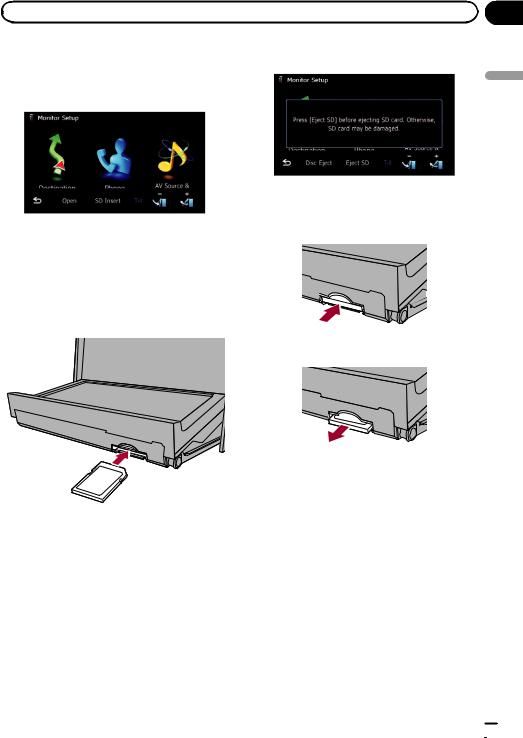
|
Chapter |
Basic operation |
02 |
1 Press the hbutton.
The “Monitor Setup” screen appears.
2 Touch [SD Insert].
The LCD panel opens, and the SD card slot appears.
3 Insert an SD memory card into the SD card slot.
Insert it with the label surface facing to the upside and press the card until it clicks and completely locks.
4 Press the hbutton.
The LCD panel closes.
pIf data related to map data, such as customized POI data, is stored on the SD memory card, the navigation system restarts.
Ejecting an SD memory card (for AVIC-Z130BT)
1 Press the hbutton.
The “Monitor Setup” screen appears.
2 Touch [Eject SD].
The LCD panel opens.
3 Press the middle of the SD memory card gently until it clicks.
4 Pull the SD memory card out straight.
5 Press the hbutton.
The LCD panel closes.
pWhen you eject the SD memory card by touching [Eject SD], the model information that you are using will be automatically stored into the SD memory card.
The utility program AVIC FEEDS will use this information to recognize the model that you use.
When the data related to map data is stored
p This description is for AVIC-Z130BT.
operation Basic
En  17
17
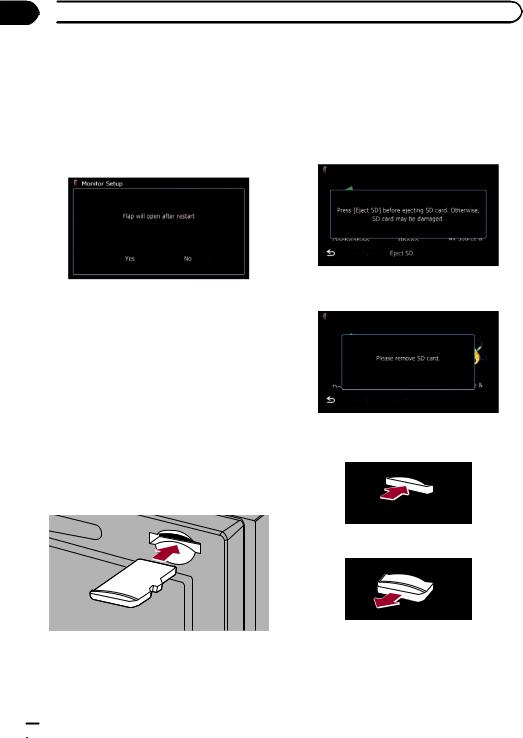
Chapter
02  Basic operation
Basic operation
If data related to map data, such as customized POI data, is stored on the SD memory card, operating procedures are slightly different.
1Press the hbutton and then touch [Eject SD].
2Touch [Yes].
The navigation system restarts, and then the LCD panel opens.
3Eject the SD memory card.
4Press the hbutton.
The LCD panel closes.
Inserting an SD memory card (for AVIC-X930BT and AVIC-X9310BT)
% Insert an SD memory card into the SD card slot.
Insert the SD memory card with the terminal contacts facing down, and press the card until it clicks and locks completely.
pIf data related to map data, such as customized POI data, is stored on the SD memory card, the navigation system restarts.
Ejecting an SD memory card (for AVIC-X930BT and AVIC-X9310BT)
1 Press the hbutton.
The touch panel keys for ejecting the media appear.
2 Touch [Eject SD].
A message prompting you to remove the SD memory card appears.
3 Press the middle of the SD memory card gently until it clicks.
4 Pull the SD memory card out straight.
When the data related to map data is stored
pThis description is for AVIC-X930BT and AVIC-X9310BT.
 18
18 En
En
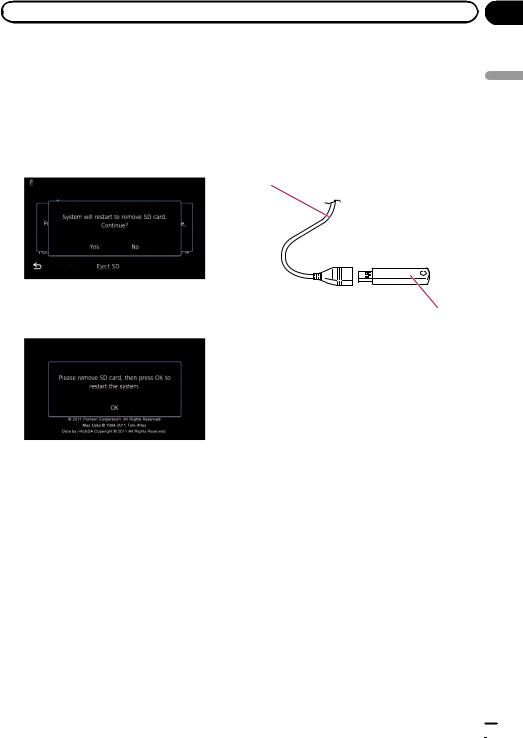
|
Chapter |
Basic operation |
02 |
If data related to map data, such as customized POI data, is stored on the SD memory card, operating procedures are slightly different.
1Press the hbutton and then touch [Eject SD].
2Touch [Yes].
The navigation system restarts, and a message prompting you to remove the SD memory card appears.
3Eject the SD memory card while the message is displayed.
Eject the SD memory card before touching [OK].
4Touch [OK].
The navigation system restarts.
Plugging and unplugging a USB storage device
 CAUTION
CAUTION
!To prevent data loss and damage to the storage device, never remove it from this navigation system while data is being transferred.
!If data loss or corruption occurs on the storage device for any reason, it is usually not
possible to recover the data. Pioneer accepts no liability for damages, costs or expenses arising from data loss or corruption.
Plugging in a USB storage device
% Plug a USB storage device into the USB and mini-jack connector.
USB and mini-jack connector
USB storage device
pCompatibility with all USB storage devices is not guaranteed.
This navigation system may not achieve optimum performance with some USB storage devices.
p Connection via a USB hub is not possible.
Unplugging a USB storage device
% Pull out the USB storage device after checking that no data is being accessed.
Connecting and disconnecting an iPod
 CAUTION
CAUTION
!To prevent data loss and damage to the storage device, never remove it from this navigation system while data is being transferred.
!If data loss or corruption occurs on the storage device for any reason, it is usually not possible to recover the data. Pioneer accepts no liability for damages, costs or expenses arising from data loss or corruption.
operation Basic
En  19
19
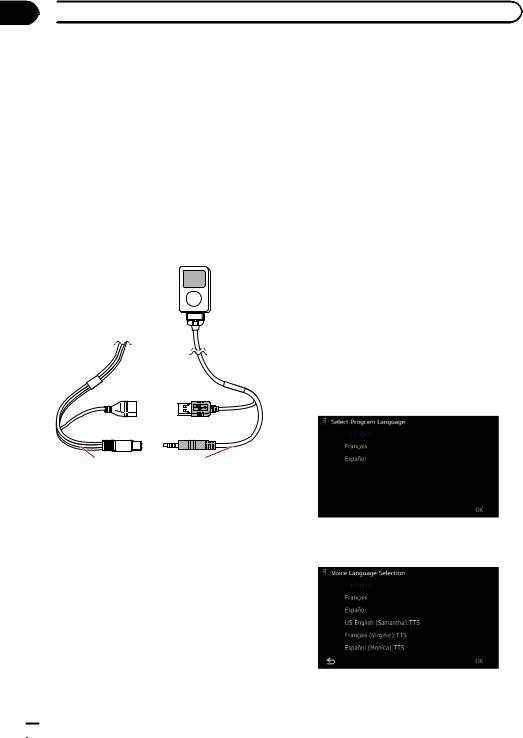
Chapter
02  Basic operation
Basic operation
Connecting your iPod
Using the USB interface cable for iPod enables you to connect your iPod to the navigation system.
pA USB interface cable for iPod (CD-IU51V) (sold separately) is required for connection.
pFor details about iPod compatibility with this navigation system, refer to the informa-
tion on our website.
p Connection via a USB hub is not possible.
1Check that no USB storage device is connected.
2Connect your iPod.
Startup and termination
1Start the engine to boot up the system.
After a short pause, the splash screen comes on for a few seconds.
p To protect the LCD screen from damage, be sure to touch the touch panel keys with your finger only and gently touch the screen.
2Turn off the vehicle engine to termi-
nate the system.
The navigation system is also turned off.
On first-time startup
When you use the navigation system for the first time, select the language that you want to use.
1Start the engine to boot up the system.
After a short pause, the splash screen comes on for a few seconds.
2Touch the language that you want to use on the screen.
USB and mini-jack con- |
USB interface cable for |
nector |
iPod |
Disconnecting your iPod
% Pull out the USB interface cable for iPod after checking that no data is being accessed.
3 Touch the language that you want to use for the voice guidance.
The navigation system will now restart.
 20
20 En
En
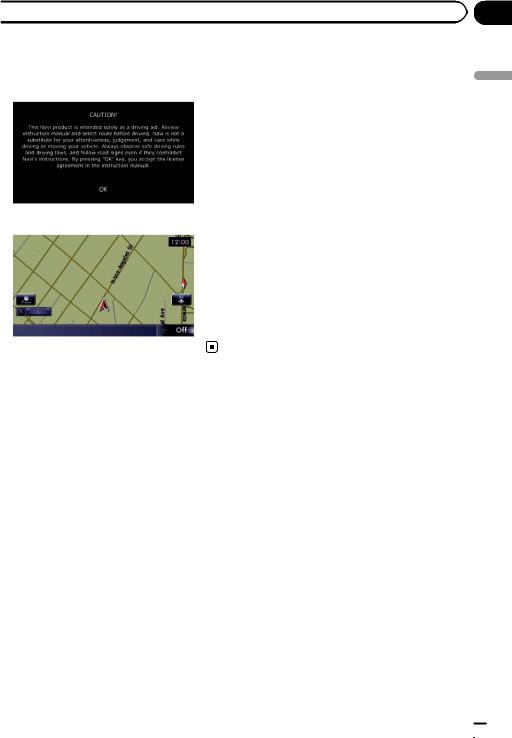
 Basic operation
Basic operation
4 Read the disclaimer carefully, checking its details, and then touch [OK] if you agree to the conditions.
The map screen appears.
Regular startup
% Start the engine to boot up the system.
After a short pause, the splash screen comes on for a few seconds.
pThe screen shown will differ depending on the previous conditions.
pWhen there is no route, the disclaimer appears after the navigation system reboots.
Read the disclaimer carefully, checking its details, and then touch [OK] if you agree to the conditions.
pIf the anti-theft function is activated, you must enter your password.
Read the disclaimer carefully, checking its
details, and then touch [OK] if you agree to the conditions.
Chapter
02 |
operation Basic
En  21
21
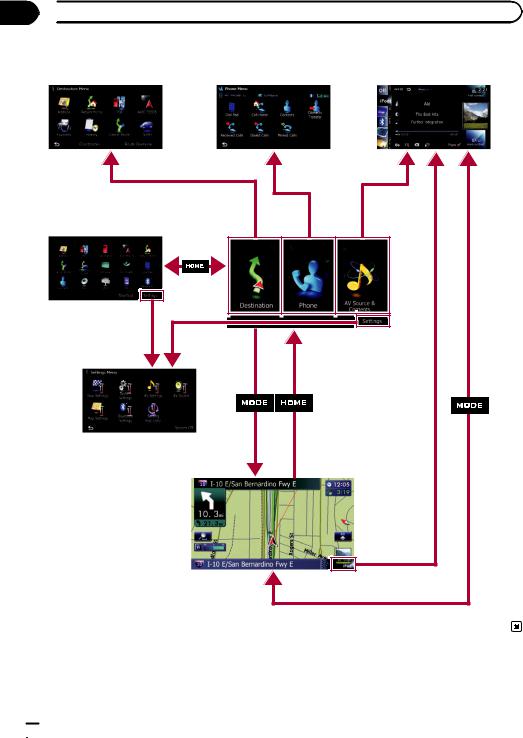
Chapter
03 How to use the navigation menu screens
How to use the navigation menu screens
Screen switching overview
2 |
3 |
4 |
1 |
|
1 |
5
6
 22
22 En
En
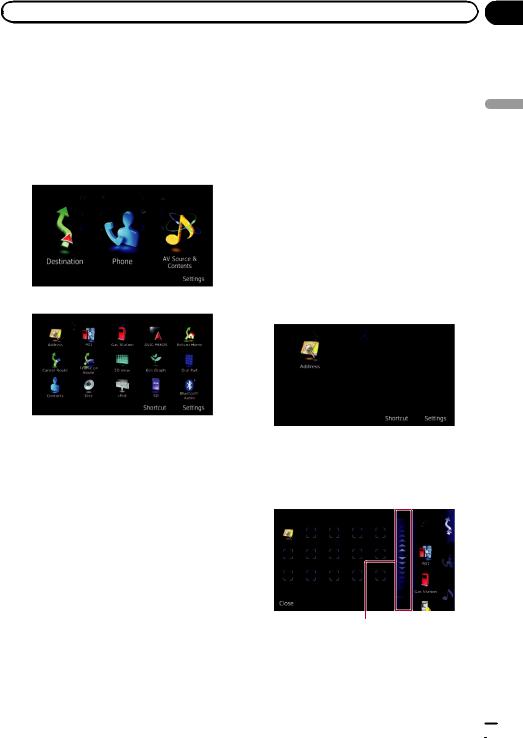
|
Chapter |
How to use the navigation menu screens |
03 |
What you can do on each menu
1Top Menu
Press the HOME button to display the “Top Menu” screen.
This is the starting menu to access the desired screens and operate the various functions. There are two types of the “Top Menu” screen.
Classic Menu
Shortcut Menu
p In this manual, Classic Menu will be referred to as “Top Menu”.
2Destination Menu
You can search for your destination on this menu. You can also check or cancel your set route from this menu.
3Phone Menu
You can access the screen that is related to hands-free phoning.
4AV operation screen
This is the screen that normally appears when you play the AV source.
5Settings Menu
You can access the screen to customize settings.
6Map screen
You can use this screen to check the current
vehicle position information and route to the destination.
Shortcut Menu
Registering your favorite menu items in short- |
|
||
cuts allows you to quickly jump to the regis- |
|
||
tered menu screen by a simple touch on the |
to How |
||
Shortcut Menu screen. |
|||
Selecting the shortcut |
|||
p |
Up to 15 menu items can be registered in |
use |
|
|
|||
|
shortcuts. |
the |
|
1 Press the HOME button repeatedly to |
|||
navigation |
|||
display the Shortcut Menu screen. |
|||
|
|||
|
p When you use the navigation system for the |
|
|
|
first time or no items are set on shortcut, a |
|
|
|
message will appear. Touch [Yes] to pro- |
|
|
|
ceed to next step. |
screensmenu |
|
2 |
Touch [Shortcut]. |
||
|
|||
The Shortcut selection screen appears.
3 Touch the tab on the right edge or scroll the bar to display the icon that you want to set to shortcut.
Scroll bar
4 Touch and hold the icon that you want to add to shortcut.
En  23
23
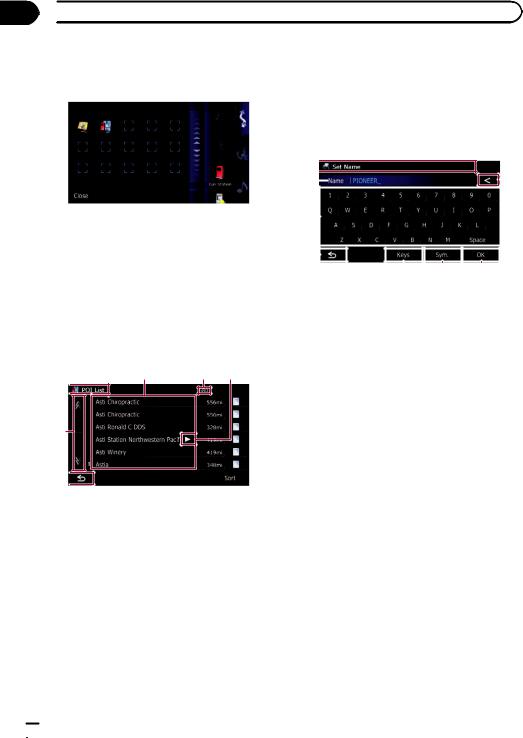
Chapter
03  How to use the navigation menu screens
How to use the navigation menu screens
5 Move the icon to the left side of the screen, and then release it.
The selected item is added to shortcut.
Removing a shortcut
1Touch and hold the icon of the shortcut you want to remove.
2Move the icon to the right side of the screen, and then release it.
Operating list screens (e.g. POI list)
4 |
5 |
6 |
1
2
3
1Screen title
2

Touching  or
or  on the scroll bar scrolls through the list and allows you to view the re-
on the scroll bar scrolls through the list and allows you to view the re-
maining items.
3
The previous screen returns.
4Listed items
Touching an item on the list allows you to narrow down the options and proceed to the next operation.
5Number of possible choices
p If there are 10 000 or more possible choices, “****” is displayed.
6

If all of the characters cannot be displayed within the displayed area, touching the key to the right of the item allows you to see remaining characters.
Operating the on-screen keyboard
1
2 |
|
|
|
|
|
|
8 |
|
3 |
|
|
|
|
|
|
|
|
|
|
|
|
|
|
|
|
|
|
|
|
|
|
|
|
|
|
4 |
|
|
|
|
|
|
|
|
|
|
|
|
|
|
|
|
|
|
|
|
|
|
|
|
|
|
|
|
|
|
|
|
|
|
|
|
|
|
|
|
|
|
||
5 |
6 |
7 |
|
|||||
1Screen title
The screen title appears.
2Text box
Displays the characters that are entered. If there is no text in the box, an informative guide with text appears.
3Keyboard
Touch the keys to enter the characters.
4
The previous screen returns.
5Keys
Switches the on-screen keyboard layout.
6Sym., Others, 0-9
You can enter other characters of alphabet. You can also enter text with marks such as [&] or [+] or numbers.
Touch to toggle the selection.
p Even if you use any of “A”, “Ä”, “Å”, “Æ”, the displayed result is the same.
7OK
Confirms the entry and allows you to proceed to the next step.
8
Deletes the input text one letter at a time, be-
ginning at the end of the text. Continuing to touch the button deletes all of the text.
 24
24 En
En
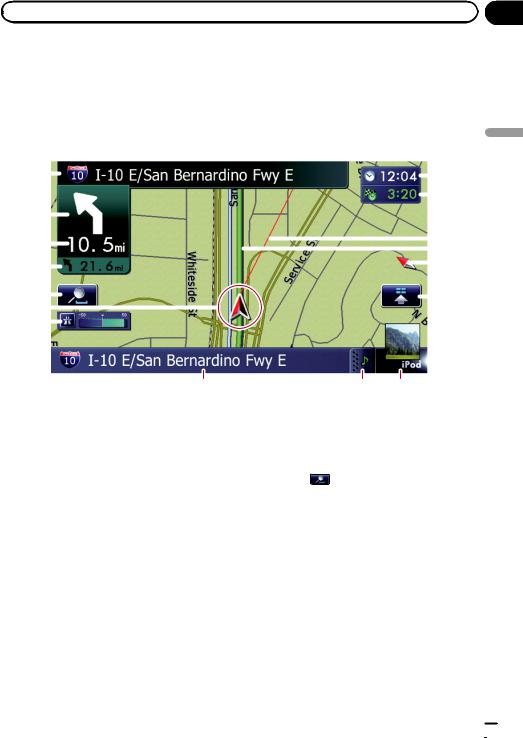
|
Chapter |
How to use the map |
04 |
Most of the information provided by your navigation system can be seen on the map. You need to become familiar with how information appears on the map.
How to read the map screen
This example shows an example of a 2D map screen. |
|
|
|
|||||||
1 |
|
|
|
|
|
|
|
|
|
g |
|
|
|
|
|
|
|
|
|
||
2 |
|
|
|
|
|
|
|
|
|
f |
|
|
|
|
|
|
|
|
|
||
|
|
|
|
|
|
|
|
|
e |
|
|
|
|
|
|
|
|
|
|
||
3 |
|
|
|
|
|
|
|
|
|
|
|
|
|
|
|
|
|
|
|
||
|
|
|
|
|
|
|
|
|
d |
|
|
|
|
|
|
|
|
|
|
|
|
4 |
|
|
|
|
|
|
|
|
|
c |
|
|
|
|
|
|
|
|
|||
|
|
|
|
|
|
|
|
|
|
|
5 |
|
|
|
|
|
|
|
|
|
b |
|
|
|
|
|
|
|
|
|||
6 |
|
|
|
|
|
|
|
|
|
|
|
|
|
|
|
|
|
|
|
|
|
7 |
|
|
|
|
|
|
|
|
|
|
|
|
|
|
|
|
|
|
|
|
|
8 |
|
9 |
a |
p Information with an asterisk (*) appears |
Shows the turning direction after next gui- |
||
only when the route is set. |
dance point and the distance to there. |
||
p Depending on the conditions and settings, |
= For details, refer to Displaying maneu- |
||
some items may not be displayed. |
vers on page 159. |
|
|
1 Name of the street to be used (or next gui- |
5 Map control |
|
|
dance point)* |
Touching |
displays touch panel keys for |
|
2 Next direction of travel* |
changing the map scale and the map orienta- |
||
As you get closer to the guidance point, the |
tion. |
|
|
color of the item changes to green. |
6 Current position |
|
|
p Touching this item enables you to hear |
Indicates the current location of your vehicle. |
||
the next guidance again. |
The apex of the triangular mark indicates your |
||
p You can select between display and |
orientation and the display moves automati- |
||
non-display. |
cally as you drive. |
|
|
= For details, refer to Displaying man- |
p The apex of the triangular mark is the |
||
euvers on page 159. |
proper current position of the vehicle. |
||
3 Distance to the guidance point* |
7 Eco-Meter |
|
|
Shows the distance to the next guidance |
Displays a graph comparing the past average |
||
point. |
fuel mileage and the average fuel mileage |
||
p Touching this item enables you to hear |
since the navigation system was last started. |
||
the next guidance again. |
= For details, refer to Displaying the fuel |
||
4 Second Maneuver Arrow* |
consumption information on page 159. |
||
map the use to How
En  25
25
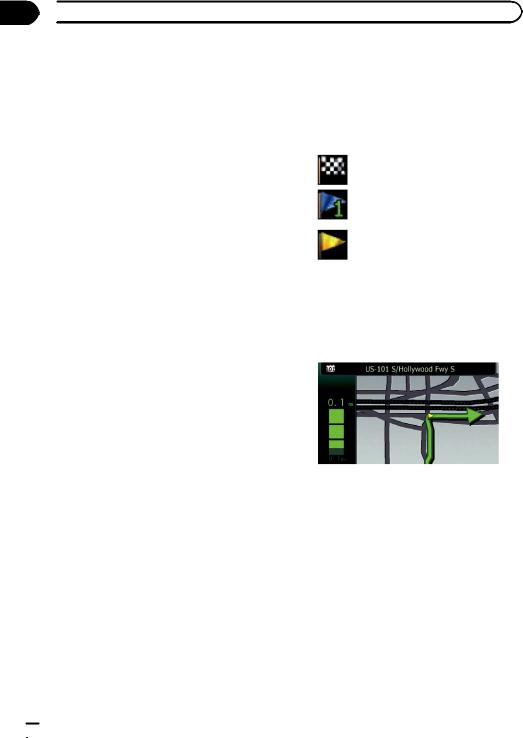
Chapter
04  How to use the map
How to use the map
8Street name (or city name) that your vehicle is traveling along
=For details, refer to Setting the current street name display on page 158.
9Extension tab for the AV information bar
Touching this tab opens the AV information bar and enables you to briefly view the current status on the AV source. Touching it again re-
tracts the bar.
aShortcut to the AV operation screen
The AV source currently selected is shown. Touching the indicator displays the AV operation screen of the current source directly.
p Depending on the source currently chosen, an image is displayed.
bQuick Access icon
Displays the “Quick Access” menu.
=For details, refer to Using shortcut menus on the map on page 29.
cMap orientation indicator
! When “North up” is selected,  is displayed.
is displayed.
! When “Heading up” is selected,  is displayed.
is displayed.
p The red arrow indicates north.
=For details, refer to Switching the map orientation on page 28.
dCurrent route*
The route currently set is highlighted in color on the map. If a waypoint is set on the route, the route after the next waypoint is highlighted in another color.
eDirection line*
The direction towards your destination (next waypoint, or the position of a cursor) is indicated with a straight line.
fMulti-Info window
Each touch of Multi-Info window changes the display information as follows.
! Distance to the destination (or distance to waypoint)*
! Estimated time of arrival at your destination or waypoint*
The estimated time of arrival is an ideal value calculated based on the value set for “Average Speed” and the actual driving speed. The estimated time of ar-
rival is only a reference value, and does not guarantee arrival at that time.
!Travel time to your destination or waypoint*
g Current time
Meaning of guidance flags
Destination
The checkered flag indicates your destination.
Waypoint
The blue flags indicate your waypoints.
Guidance point
The next guidance point (next turning point, etc.) is shown by a yellow flag.
Enlarged map of the intersection
When “Close Up View” in the “Map Settings” screen is “On”, an enlarged map of the intersection appears.
=For details, refer to Setting the auto-zoom display on page 156.
 26
26 En
En

|
Chapter |
How to use the map |
04 |
Display during freeway driving
In certain locations of the freeway, lane information is available. The map indicates the recommended lane to be in to easily maneuver the next guidance.
1
While driving on the freeway, freeway exit numbers and freeway signs may be displayed in the vicinity of interchanges and exits.
2 3
1Lane information
2Freeway exit information
Displays the freeway exit.
3Freeway signs
These show the road number and give directional information.
pIf the data for these items is not contained in the built-in memory, the information is
not available even if there are the signs on the actual road.
Types of the road stored in the map database
Roads included in the route guidance
Turn by Turn Routable Roads contain full attribute data and can be used for full Route Guidance. Pioneer Navigation will display full
route guidance, including turn-by-turn voice directions and arrow icons.
Roads without turn-by-turn instructions
Routable roads (the route displayed and highlighted in violet) have only basic data and can only be used to plot a navigable route. Pioneer Navigation will only display a navigable route on the map (only the arrival guidance for the destination or a waypoint is available). Please review and obey all local traffic rules along the highlighted route for your safety.
No turn-by-turn directions will be displayed on these roads.
Non routable roads (pink color road)
Map display is possible, but it cannot be used for route calculation. Please review and obey all local traffic rules along this route. (For your safety.)
Operating the map screen
Changing the scale of the map
You can change the map scale between 25 yards and 1 000 miles (25 meters and 2 000 kilometers).
1Display the map screen.
2Touch  on the map screen.
on the map screen.
 and
and  with the map scale appear.
with the map scale appear.
map the use to How
En  27
27
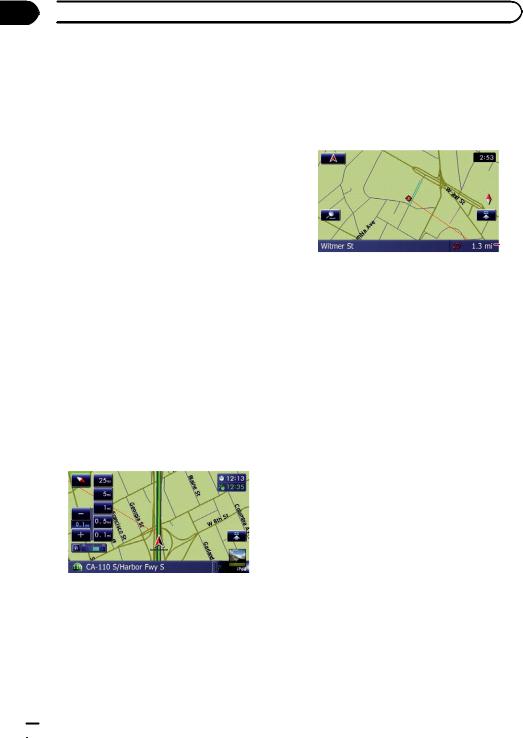
Chapter
04  How to use the map
How to use the map
3 Touch  or
or  to change the map scale.
to change the map scale.
pIf you do not operate the function for a few seconds, the touch panel keys for map display control disappear.
#If you touch the direct scale key, the map is changed to the selected scale directly.
Scrolling the map to the position you want to see
1Display the map screen.
2Touch and drag the map in the desired direction to scroll.
Switching the map orientation
You can switch how the map shows your vehicle’s direction between “Heading up” and “North up”.
!Heading up:
The map display always shows the vehicle’s direction as proceeding toward the top of the screen.
!North up:
The map display always has north at the top of the screen.
pThe map orientation is fixed at “North up” when the map scale is 25 miles (50 kilo-
meters) or more.
pThe map orientation is fixed at “Heading up” when the 3D map screen is displayed.
1Display the map screen.
2Touch  on the map screen.
on the map screen.
 or
or  appears.
appears.
1
2
1Cursor
2Distance from the current position
Positioning the cursor to the desired location results displaying in a brief informational overview about the location at the bottom of screen, with the street name and other information for this location. (The information shown varies depending on the position.)
p The scrolling increment depends on your dragging length.
#If you touch  , the map returns to the current position.
, the map returns to the current position.
p Pressing MODE button returns the map to the current position.
3 Touch  or
or  to switch the vehicle’s direction.
to switch the vehicle’s direction.
Each time you touch the key changes the setting.
pIf you do not operate the function for a few seconds, the touch panel keys for map display control disappear.
Viewing information about a specified location
An icon appears at registered places (home location, specific places, Favorites entries) and places where there is a POI icon or traffic information icon. Place the scroll cursor over the icon to view detailed information.
1 Scroll the map and move the scroll cursor to the icon you want to view.
 28
28 En
En
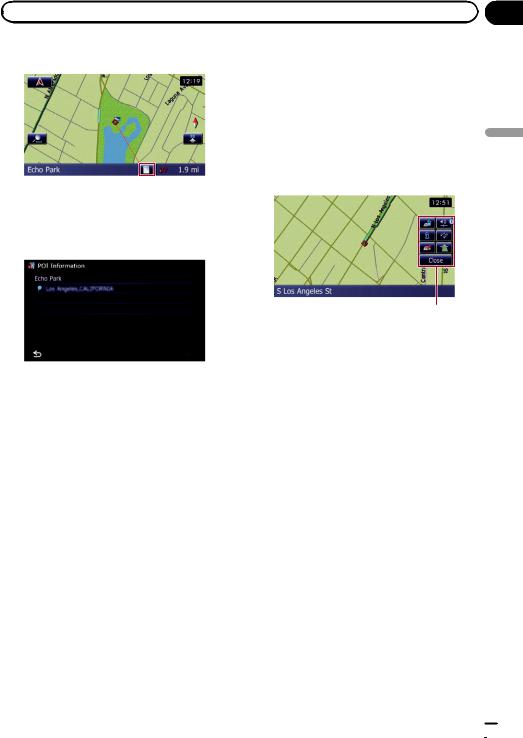
|
Chapter |
How to use the map |
04 |
2 Touch  .
.
The “Information List” screen appears.
3 Touch the item that you want to check the detailed information.
Information for a specified location appears.
You can customize “Quick Access” displayed on screen. The “Quick Access” described here are prepared as the default setting.
= For details, refer to Selecting the “Quick Access” menu on page 162.
pItems marked with an asterisk (*) cannot be removed from the “Quick Access” menu.
% When the map is displayed, touch  .
.
map the use to How
The information shown varies according to the location. (There may be no information for that location.)
=For details, refer to Setting the display of icons of favorite locations on page 158.
=For details, refer to Displaying POI on the map on page 159.
=For details, refer to How to read traffic infor- mation on the map on page 52.
pTouching [Call] enables you to call the position if a telephone number is available. (Pairing with cellular phone featuring Bluetooth wireless technology is required.)
=For details, refer to Dialing from the map on page 64.
Using shortcut menus on the map
“Quick Access” menu allows you to perform various tasks, such as route calculation for the location indicated by the cursor or registering a location in “Favorites”, faster than using the navigation menu.
Quick Access menu
 : Route Options*
: Route Options*
Displayed when the map is not scrolled. This item can be selected only during route guidance.
You can modify the conditions for route calculation and recalculate the current route.
=For details, refer to Modifying the route calculation conditions on page 43.
 : Destination*
: Destination*
Displayed when the map is scrolled. Set the route to the place specified with the cursor.  : Registration
: Registration
Register information on the location indicated by the cursor to “Favorites”.
=For details, refer to Registering a location by scroll mode on page 47.
 : Vicinity Search
: Vicinity Search
Find POIs (Points Of Interest) in the vicinity of the cursor.
=For details, refer to Searching for a nearby POI on page 38.
 : Overlay POI
: Overlay POI
Displays icons for surrounding facilities (POI) on the map.
=For details, refer to Displaying POI on the map on page 159.
 : Volume
: Volume
En  29
29
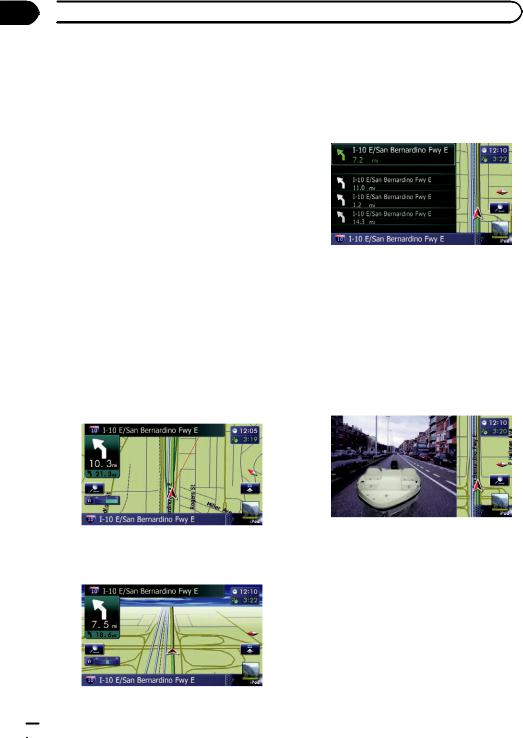
Chapter
04  How to use the map
How to use the map
Displays the “Volume Settings” screen.
= For details, refer to Setting the Volume for Guidance and Phone on page 165.
 : Contacts
: Contacts
Displays the “Contacts List” screen.
=For details, refer to Calling a number in the phone book on page 62.
Close
Hides the “Quick Access” menu.
Switching the view mode
Various types of screen displays can be selected for navigation guidance.
1Display the “Map Settings” screen.
=For details, refer to Displaying the screen for map settings on page 156.
2Touch [View Mode].
The “View Mode” screen appears.
3 Touch the type that you want to set.
You can select the following types:
!2D View (default):
Displays a normal map (2D map).
!3D View:
Displays a map with an antenna view (3D map).
!Street View:
Information on the next four guidance points closest to the current location appear in order from top to bottom on the left side of the screen. The following information is displayed.
—Name of the next route to be taken by the vehicle
—Arrow indicating the direction of the vehicle
—Distance to the guidance points
pThis mode is available when the route is set.
!Rear View:
Displays the rear view image on the left side of the screen and the map on the right side of the screen.
pThis mode is available when the rear view camera setting is set to “On”.
=For details, refer to Setting for rear view camera on page 166.
!Eco Graph:
Displays a graph for eco-driving on the left side of the screen and the map on the right side of the screen.
 30
30 En
En
